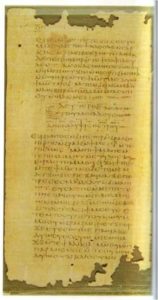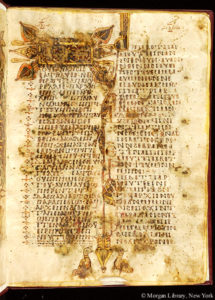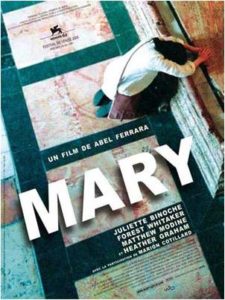2018 New Testament Apocrypha Course: Week 6
Our first of two classes on Passion and resurrection gospels began and ended with the Gospel of Mary. We read the conclusion to Gos. Mary as a group and I had the class consider who the Mary of the text is (the Marys tend to blur in apocryphal traditions), why the apostles doubt her vision (did the author anticipate resistance to the text’s “strange teachings”?), and what to make of the interplay between Peter and Mary (a microcosm of orthodox and “heretical” group conflicts?).

We carried this discussion of orthodoxy and heresy into our discussion of the next text examined this week: the Revelation of Peter. As a Nag Hammadi text, Rev. Peter is not usually discussed among Passion gospels, but it is set during the crucifixion of Jesus. Its docetic Christology—i.e., the divine Christ only “seemed” to be human, and departed the body of Jesus of Nazareth at the crucifixion—makes Rev. Peter one of the most controversial texts among the Christian Apocrypha and elicited much discussion from the class. We followed up Rev. Peter with a look at other texts that share the crucifixion-substitution motif, including Irenaeus’s description of the teaching of Basilides, the Second Treatise of the Great Seth, the Acts of John, the Qur’an (Sura 4.157), and the Gospel of Barnabas. To supplement this survey of literature we looked also at a segment from the documentary Secret Lives of Jesus focusing on Basilides and Rev. Peter.
The Gospel of Barnabas’s use of Judas as the substitute for Jesus led into a brief look at the Gospel of Judas. I usually save in-depth discussion of Gos. Judas for my Gnosticism course starting, so I did not want to spend too much time on the text this week. We simply examined the text’s polemic against orthodox Christianity from 38,1-39,5: “Some sacrifice their own children, others their wives, while praising and blaming each other. Some have sex with men. Some perform acts of murder,” etc.
The most well-known apocryphal Passion narrative, the Acts of Pilate, is a text that I have always struggled to master. There are far too many manuscripts (500!), in a great variety of languages (not only Greek, Latin, and Syriac but also Armaic, Armenian, Georgian, and vernaculars), and with way too many variants. And then there are all the other texts of the Pilate Cycle, and the medieval homilies that incorporate them. Oy. To my surprise, our primary text reader (Ehrman’s Lost Scriptures) does not contain Acts Pilate. So, I went through the contents of the Greek A version with the class, noting some of its more interesting features (its treatment of Jewish complicity in the trial of Jesus, its added biographical details to some of the characters from the canonical Gospels). This was followed by a quick discussion of the Descent to Hell tradition of the Greek B text, supplemented with a minor detour into the Barnabas texts (Questions of Barnabas, Book of the Resurrection of Jesus Christ by Bartholomew) that also preserve this tradition.

We could not spend any time on the other Pilate Cycle texts, but I did manage to squeeze in some brief descriptions of two lesser-known Passion accounts: the Book of the Rooster and the recently-published On the Life and the Passion of Christ attributed to Cyril of Jerusalem. They both contain some curious features. In Bk. Rooster, Paul participates in the arrest and crucifixion of Jesus (he even places the crown of thorns on Jesus’ head). And in the Ps.-Cyril text, Judas needs to identify Jesus with a kiss because Jesus can take on many forms, and Pilate offers to sacrifice his own son in Jesus’ place. One other aspect of the text that was mentioned in my notes, but not discussed in class, is the physical description it offers of Jesus. Since we spent some time last week on the description of Jesus from the Epistle of Lentulus, I promised the class I would provide them with the passage from Ps.-Cyril, which reads, “As, then, they brought Jesus before him, he looked at him for a long time, marveling at his beauty and his youth. This is his appearance: he is corn-coloured, his hair is black, coming down to his shoulders like bunches of grapes, his nose is prominent, he has beautiful eyes, his eyebrows are joined together, his cheeks are red like roses. He wears a grape-coloured tunic, he has silver-studded adornments on his side, like a sword, and a linen garment covers him so that he looks like a royal son” (114).
 In our last half hour we returned to Gos. Mary for a discussion of Mary Magdalene in canonical and noncanonical traditions. I noted that her role as a representative of forms of Christianity with more opportunities for women is given support by evidence outside the text, including Tertullian’s indictment of Christian groups who allow women to lead, preach, and baptize, and the female recipient of Ptolemy’s Epistle to Flora. We finished with a few scenes from the 2005 film Mary, starring Juliette Binoche as an actress playing Mary Magdalene in a film within the film. Three scenes are based on Gos. Mary (incorporating roughly half of the text from 10,1-18,10), and others show Mary interacting with Jesus and the male apostles. Other scenes show Theodore Younger (played by Forest Whitaker) viewing footage of Elaine Pagels and other scholars discussing the text. I remarked that Mary is perhaps the most accurate portrayal of an apocryphal text on film, yet there is no acknowledgement made of the source of the material—a viewer could come away from it thinking the scenes from Gos. Mary are the invention of the filmmaker. Before I adjourned the class for Reading Week, we took a look at the trailer for the new film Mary Magdalene to be released in time for Easter. It is unclear from the trailer what, if any, apocryphal traditions it includes, but it certainly presents Mary as an important force in Jesus’ life.
In our last half hour we returned to Gos. Mary for a discussion of Mary Magdalene in canonical and noncanonical traditions. I noted that her role as a representative of forms of Christianity with more opportunities for women is given support by evidence outside the text, including Tertullian’s indictment of Christian groups who allow women to lead, preach, and baptize, and the female recipient of Ptolemy’s Epistle to Flora. We finished with a few scenes from the 2005 film Mary, starring Juliette Binoche as an actress playing Mary Magdalene in a film within the film. Three scenes are based on Gos. Mary (incorporating roughly half of the text from 10,1-18,10), and others show Mary interacting with Jesus and the male apostles. Other scenes show Theodore Younger (played by Forest Whitaker) viewing footage of Elaine Pagels and other scholars discussing the text. I remarked that Mary is perhaps the most accurate portrayal of an apocryphal text on film, yet there is no acknowledgement made of the source of the material—a viewer could come away from it thinking the scenes from Gos. Mary are the invention of the filmmaker. Before I adjourned the class for Reading Week, we took a look at the trailer for the new film Mary Magdalene to be released in time for Easter. It is unclear from the trailer what, if any, apocryphal traditions it includes, but it certainly presents Mary as an important force in Jesus’ life.

Sorry I missed this class…was great to have such a in depth review of what we covered! Thanks.
Many thanks for the post. I must now go and watch the 2005 Mary film. This had somehow passed me by.
Thanks for the information. I missed this class. very happy to read your article such a nice post. Gospel